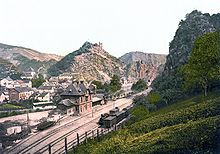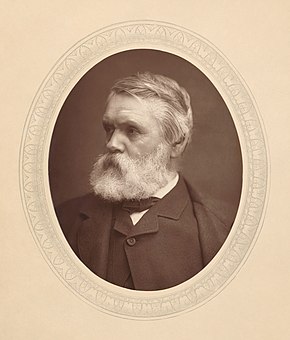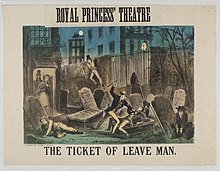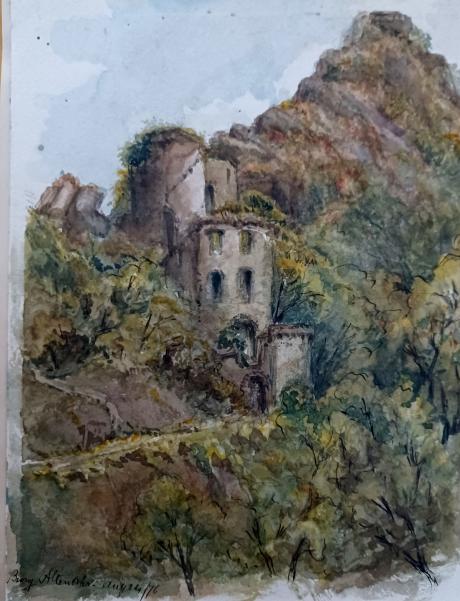inscribed and dated "Are Castle Altenah Aug 24 1876" and signed with initials "TT"
Tom and Laura Taylor and thence by descent
Are Castle is the ruin of a hill castle that stands at a height of 240 m above sea level (NHN) above the village of Altenahr in the German state of Rhineland-Palatinate. It was built around 1100 by Count Dietrich I of Are and is first recorded in 1121.
Since 1965 the Are Gymnasium – a local grammar school – in Bad Neuenahr-Ahrweiler has borne the name which is derived from the castle and its eponymous noble family.
The plan of the castle is rectangular. As well as parts of the outer ward and a gate – the so-called Gymnicher Porz – remains of the defensive wall have survived. In addition, on the southern side of the site, is an old gate tower (also called the Schellenturm), as well as the ruins of the palas, which once had a heated bishop's chamber. The first bergfried probably stood on the pointed dome of rock in its northern corner. North of that are extensive remains of the Romanesque castle chapel dating to the 12th century.

Below Are Castle lie the remains of the Gymnicher Porz, Porz standing for Pforte or "portal". This was the lower gateway on the access road to the castle which, in combination with a wall, barred the way to the castle hill. The structure comprised a gatehouse over the access road, an attached castle house (Burghaus), with a basement and two floors housing living accommodation, and an attached tower. It took its name from the House of Gymnich. Several members of the family held the castle in fief (they were ‘’Pfandnehmer’’) in the 14th and 16th centuries. It is suspected that the gate system was built during this time. From time to time the Gymnicher Porz was an independent fief (Burglehen) of the House of Gymnich.
From 1997 to 1999 the ruins were made safe at a high financial cost and classed as a protected monument. Since then they have been open to the public once more. The conservation work that began in March 1997 had the primary purpose of protecting traffic. There was a risk of rocks and stones from the site falling onto the federal highway. The construction material was transported to the castle site on a cable suspended from a Hughes 500 helicopter. After 30 flights the laden helicopter crashed on 9 April 1997 because the cable caught on its skids. The pilot received fatal injuries.
In autumn 1997 the 22-metre (72 ft) long palas wall and its two side walls were restored. To guarantee the stability of the walls, 65 anchors were driven up to 14 metres (46 ft) deep into the slate rock.

In 1246 Count Frederick of Hochstaden, provost of Xanten, with the assent of his brother Conrad of Are-Hochstaden gifted the county and its castles - Are, Hardt and Hochstaden – to the Archbishopric of Cologne. Its expansion with a surrounding enceinte was carried out during the period of Electoral Cologne in the 14th and 15th centuries in order to protect the Electorate's estates in the Ahr region. In the 16th and 17th centuries there were only minor changes to the castle in the form of repairs and replacement buildings. Periodically the castle was also used as a gaol in which the archbishops of Cologne incarcerated their enemies. For a long time Are Castle was a spiritual and cultural centre for the whole area.
Increasingly often, the archbishops of Cologne enfeoffed Are Castle with the district (Amt) of Altenahr. The liegemen were installed as Amtmännern and most of the also lived at the castle. Over a long time the castle fell into a poor state of repair because the vassals did not carry out the necessary work. One exception was the period of Henry of the Horst, who died in 1625.
In 1690 the castle was captured by French troops after a nine-month siege. The castle was badly damaged by shelling. In 1697 the French withdrew, but occupied the castle again during the War of the Spanish Succession that began in 1701. In 1706 the castle was taken over by Electoral Cologne forces and the area became unsafe. For this reason Prince Elector Joseph Clemens of Bavaria had the walls blown up in 1714 with the agreement of the villagers. Since then the castle has been a ruin. Reusable materials such as wood and stone were used as construction materials for the rebuilding of the district house (Amtshaus) at the foot of the castle hill.
-
The castle and Gymnicher Porz around 1830
-
The castle and gateway today from a similar standpoint
-
Inner ward
-
Ruins of the castle house of the Gymnicher Porz with the remains of the chimney
-
Castle chapel
A Sigewin of Are, Archbishop of Cologne is mentioned in the records as early as 1087, but Dietrich I of Are is viewed as the primogenitur of the House of Are. The comital family named themselves after the river Ahr, whose surrounding area they owned. In 1140 the family divided into the lines of Are-Hochstaden and Are-Nürburg. Members of the family include:
- Gerhard of Are, from 1124 to 1169 provost of Bonn's Cassius foundation (Cassius-Stift), who had the Bonn Minster church enlarged.
- Frederick II of Are, 1152 to 1168 Bishop of Münster
- Lothar of Hochstaden, 1192/93 Bishop of Liège
- Dietrich II of Are, 1197 to 1212 Bishop of Utrecht
- Conrad of Hochstaden, from 1238 to 1261, Archbishop of Cologne and builder of Cologne Cathedral.

Tom Taylor (19 October 1817 – 12 July 1880) was an English dramatist, critic, biographer, public servant, and editor of Punch magazine. Taylor had a brief academic career, holding the professorship of English literature and language at University College, London in the 1840s, after which he practised law and became a civil servant. At the same time he became a journalist, most prominently as a contributor to, and eventually editor of Punch.
In addition to these vocations, Taylor began a theatre career and became best known as a playwright, with up to 100 plays staged during his career. Many were adaptations of French plays, but these and his original works cover a range from farce to melodrama. Most fell into neglect after Taylor's death, but Our American Cousin (1858), which achieved great success in the 19th century, remains famous as the piece that was being performed in the presence of Abraham Lincoln when he was assassinated in 1865.
Early years
Taylor was born into a newly wealthy family at Bishopwearmouth, a suburb of Sunderland, in north-east England. He was the second son of Thomas Taylor (1769–1843) and his wife, Maria Josephina, née Arnold (1784–1858). His father had begun as a labourer on a small farm in Cumberland and had risen to become co-owner of a flourishing brewery in Durham. After attending the Grange School in Sunderland, and studying for two sessions at the University of Glasgow, Taylor became a student of Trinity College, Cambridge in 1837, was elected to a scholarship in 1838, and graduated with a BA in both classics and mathematics. He was elected a fellow of the college in 1842 and received his MA degree the following year.

Taylor left Cambridge in late 1844 and moved to London, where for the next two years he pursued three careers simultaneously. He was professor of English language and literature at University College, London, while at the same time studying to become a barrister, and beginning his life's work as a writer. Taylor was called to the bar of the Middle Temple in November 1846. He resigned his university post, and practised on the northern legal circuit until he was appointed assistant secretary of the Board of Health in 1850. On the reconstruction of the board in 1854 he was made secretary, and on its abolition in 1858 his services were transferred to a department of the Home Office, retiring on a pension in 1876.
Writer
Taylor owed his fame and most of his income not to his academic, legal or government work, but to his writing. Soon after moving to London, he obtained remunerative work as a leader writer for the Morning Chronicle and the Daily News. He was also art critic for The Times and The Graphic for many years. He edited the Autobiography of B. R. Haydon (1853), the Autobiography and Correspondence of C. R. Leslie, R.A. (1860) and Pen Sketches from a Vanished Hand, selected from papers of Mortimer Collins, and wrote Life and Times of Sir Joshua Reynolds (1865). With his first contribution to Punch, on 19 October 1844, Taylor began a thirty-six year association with the magazine, which ended only with his death. During the 1840s he wrote on average three columns a month; in the 1850s and 1860s this output doubled. His biographer Craig Howes writes that Taylor's articles were generally humorous commentary or comic verses on politics, civic news, and the manners of the day. In 1874 he succeeded Charles William Shirley Brooks as editor.
Taylor also established himself as a playwright and eventually produced about 100 plays. Between 1844 and 1846, the Lyceum Theatre staged at least seven of his plays, including extravanzas written with Albert Smith or Charles Kenney, and his first major success, the 1846 farce To Parents and Guardians. The Morning Post said of that piece, "The writing is admirable throughout – neat, natural and epigrammatic". It was as a dramatist that Taylor made the most impression – his biographer in the Dictionary of National Biography (DNB) wrote that in writing plays Taylor found his true vocation. In thirty-five years he wrote more than seventy plays for the principal London theatres.

A substantial portion of Taylor's prolific output consisted of adaptations from the French or collaborations with other playwrights, notably Charles Reade. Some of his plots were adapted from the novels of Charles Dickens or others. Many of Taylor's plays were extremely popular, such as Masks and Faces, an extravaganza written in collaboration with Reade, produced at the Haymarket Theatre in November 1852. It was followed by the almost equally successful To Oblige Benson (Olympic Theatre, 1854), an adaptation from a French vaudeville. Others mentioned by the DNB are Plot and Passion (1853), Still Waters Run Deep (1855) and The Ticket-of-Leave Man (based on Le Retour de Melun by Édouard Brisebarre and Eugène Nus), a melodrama produced at the Olympic in 1863.Taylor also wrote a series of historical dramas (many in blank verse), including The Fool’s Revenge (1869), an adaption of Victor Hugo's Le roi s'amuse (also adapted by Verdi as Rigoletto), 'Twixt Axe and Crown (1870), Jeanne d'arc (1871), Lady Clancarty (1874) and Anne Boleyn (1875). The last of these, produced at the Haymarket in 1875, was Taylor's penultimate piece and only complete failure. In 1871 Taylor supplied the words to Arthur Sullivan's dramatic cantata, On Shore and Sea.
Like his colleague W. S. Gilbert, Taylor believed that plays should be readable as well as actable; he followed Gilbert in having copies of his plays printed for public sale. Both authors did so at some risk, because it made matters easy for American pirates of their works in the days before international copyright protection. Taylor wrote, "I have no wish to screen myself from literary criticism behind the plea that my plays were meant to be acted. It seems to me that every drama submitted to the judgment of audiences should be prepared to encounter that of readers".

Many of Taylor's plays were extremely popular, and several survived into the 20th century, although most are largely forgotten today. His Our American Cousin (1858) is now remembered chiefly as the play Abraham Lincoln was attending when he was assassinated, but it was revived many times during the 19th century with great success. It became celebrated as a vehicle for the popular comic actor Edward Sothern, and after his death, his sons, Lytton and E. H. Sothern, took over the part in revivals.
Howes records that Taylor was described as "of middle height, bearded [with] a pugilistic jaw and eyes which glittered like steel". Known for his remarkable energy, he was a keen swimmer and rower, who rose daily at five or six and wrote for three hours before taking an hour's brisk walk from his house in Wandsworth to his Whitehall office.
Some, like Ellen Terry, praised Taylor's kindness and generosity; others, including F. C. Burnand, found him obstinate and unforgiving. Terry wrote of Taylor in her memoirs:
Most people know that Tom Taylor was one of the leading playwrights of the 'sixties as well as the dramatic critic of The Times, editor of Punch, and a distinguished Civil Servant, but to us he was more than this. He was an institution! I simply cannot remember when I did not know him. It is the Tom Taylors of the world who give children on the stage their splendid education. We never had any education in the strict sense of the word yet through the Taylors and others, we were educated.
Terry's frequent stage partner, Henry Irving said that Taylor was an exception to the general rule that it was helpful, even though not essential, for a dramatist to be an actor to understand the techniques of stagecraft: "There is no dramatic author who more thoroughly understands his business".
In 1855 Taylor married the composer, musician and artist Laura Wilson Barker (1819–1905). She contributed music to at least one of his plays, an overture and entr'acte to Joan of Arc (1871), and harmonisations to his translation Ballads and Songs of Brittany (1865). There were two children: the artist John Wycliffe Taylor (1859–1925) and Laura Lucy Arnold Taylor (1863–1940). Taylor and his family lived at 84 Lavender Sweep, Battersea, where they held Sunday musical soirees. Celebrities who attended included Lewis Carroll, Charles Dickens, Henry Irving, Charles Reade, Alfred Tennyson, Ellen Terry and William Makepeace Thackeray.
Taylor died suddenly at his home in 1880 at the age of 62 and is buried in Brompton Cemetery. After his death, his widow retired to Coleshill, Buckinghamshire, where she died on 22 May 1905.






